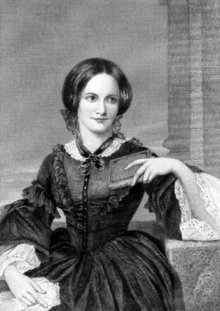Villette (novel)
|
|
Villette is a novel by Charlotte Brontė, published in 1853. After an unspecified family disaster, protagonist Lucy Snowe travels to the fictional city of Villette to teach at an all-girls school where she is unwillingly pulled into both adventure and romance. However, the novel is celebrated not so much for its plot as in its acute tracing of Lucy’s psychology, particularly Bronte’s use of Gothic doubling to represent externally what her protagonist is suffering internally.
| Contents |
Biographical background
In 1842 Brontė traveled to Brussels, Belgium with her sister Emily, where they enrolled in a pensionnat ran by M. and Mme. Constantin Heger. In return for board and tuition, Charlotte taught English and Emily taught music. Their time at the pensionnat was cut short when Elizabeth Branwell, their aunt who joined the family after the death of their mother to look after the children, died of internal obstruction in October 1842. Charlotte returned alone to Brussels in January 1843 to take up a teaching post at the pensionnat. Her second stay at the pensionnat was not a happy one; she became lonely, homesick, and somewhat attracted to M. Heger. She finally returned to her family’s rectory at Haworth in January 1844.
Brontė drew on this source material for her first, unsuccessful novel The Professor. After several publishers rejected this early work, Brontė reworked the material as a basis for Villette. In particular, most literary historians believe the character of M. Paul Emmanuel to be closely based on M. Heger.
Plot summary
Villette begins with its famously passive protagonist, Lucy Snowe, observing her godmother, Mrs. Bretton, her son, Graham Bretton, and a young visitor, Paulina Home de Bassompierre. The child Paulina is strongly attracted to the older Graham, who showers her with attention but fails to notice her in a romantic sense. An unspecified family tragedy soon forces Lucy into action, however, and she boards a ship for Labassecour (apparently Belgium) despite not speaking a word of French. Arrived in the capital city of Villette, Lucy finds work as a teacher at Mme. Beck’s school for girls, which satisfies her despite Mme. Beck’s constant surveillance of the students and staff.
John, a handsome English doctor, frequently visits the school because of his love for the heartless coquette Ginerva. In one of Villette’s more infamous plot twists, Dr. John is later revealed to be Graham Bretton, a fact that Lucy has known but deliberately concealed from the reader. After Dr. John discovers Ginerva’s unworthiness, his attentions briefly turn to Lucy, who falls seriously in love with him despite her usual emotional reserve. When Dr. John rescues Paulina from a burning theater by chance, however, the two fall in love with each other and eventually marry, leaving Lucy heartbroken.
At the same time, Lucy has the first of several encounters a shadowy nun in the attic who may be the ghost of a nun buried alive on the grounds for breaking her vows of chastity; in a highly symbolic scene, she finally finds the nun’s habit in her bed and destroys it. She later discovers it to be the disguise of one of Ginerva’s lovers.
Lucy finds herself arguing increasingly with a colleague, the autocratic, fiery schoolmaster M. Paul Emmanuel; the two eventually fall in love. However, a group of conspirators, including Mme. Beck, the priest Pere Silas, and the relatives of M. Paul’s long-dead wife, struggle to keep the two apart, and finally succeed in forcing M. Paul’s departure for the West Indies to oversee his plantation there. He nonetheless declares his love for Lucy before his departure, and arranges for her to live independently as the headmistress of her own boarding school. Villette’s final pages are ambiguous; though Lucy says that she wants to leave the reader free to imagine a happy ending, she hints strongly that M. Paul’s ship was destroyed by a storm on his return from the West Indies, killing him.
Themes
Villette is most commonly celebrated for its explorations of gender roles and repression. Lucy worries constantly about keeping her emotional and (implicitly) sexual desires in check; even her name, Snowe, suggests her reclusive, cold nature. Yet Lucy also comes to realize that her development as a human being will require her to throw off her frozen persona and express love as she chooses, and her self-assertion against Mme. Beck’s final intrusions is seen by many critics as the triumphant moment of the novel.
Many plot elements of the novel serve to echo this conflict, particularly the use of Gothic doubling. The ghostly nun, for example, echoes Lucy’s fears of being destroyed for stepping out of her repression; Mme. Beck serves as a physical counterpart to the tight self-surveillance that Lucy keeps over her emotions. Bronte also gives much attention to gender representations through art. In one of Villette’s most famous scenes, Lucy visits an art museum and critiques the presentations of women found in its paintings; she also re-writes the text of a play that she participates in, suggesting the need for women to re-envision male art to create a space for themselves. In The Madwoman in the Attic, critics Sandra Gilbert and Susan Gubar have argued that the character of Lucy Snowe is based in part on William Wordsworth's Lucy poems, further emphasizing this idea of a feminine re-writing.
Villette also incisively explores isolation and cross-cultural conflict in Lucy’s attempts to master the French language, as well as the conflicts between her English Protestantism and the Catholicism of Labassecour.
Misc
The novel has been adapted as a 3-hour radio serial for BBC Radio 4.

